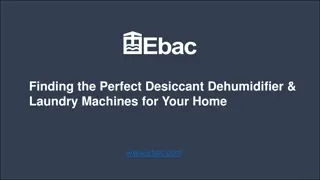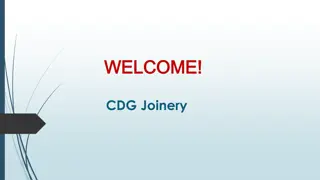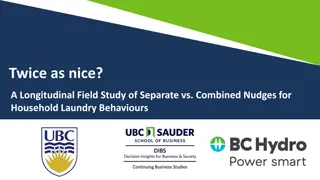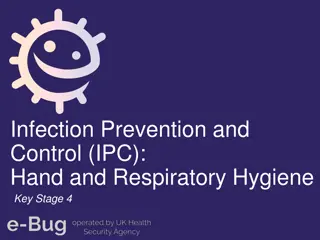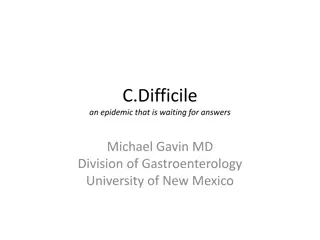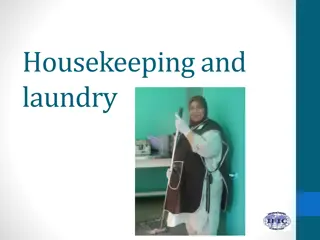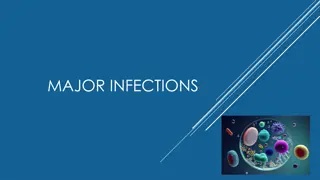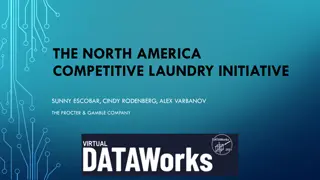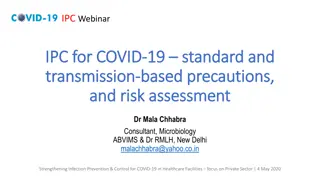Essential Guidelines for Safe Laundry Handling in Infection Prevention & Control
Laundry management is crucial in preventing infection spread. Key practices include washing hands between handling clean and used laundry, preventing cross-contamination, storing laundry properly, and handling used laundry safely. Categorize laundry into clean, used, and infectious types, and follow specific guidelines for each. It's essential to create a flow system in laundry rooms, use separate containers for different types of laundry, and handle infectious laundry with care.
Download Presentation

Please find below an Image/Link to download the presentation.
The content on the website is provided AS IS for your information and personal use only. It may not be sold, licensed, or shared on other websites without obtaining consent from the author.If you encounter any issues during the download, it is possible that the publisher has removed the file from their server.
You are allowed to download the files provided on this website for personal or commercial use, subject to the condition that they are used lawfully. All files are the property of their respective owners.
The content on the website is provided AS IS for your information and personal use only. It may not be sold, licensed, or shared on other websites without obtaining consent from the author.
E N D
Presentation Transcript
Laundry Leicester City Council Infection Prevention Control
Key messages Laundry can be a potential source of spreading infections within homes. It is important to ensure workers have the required information in relation to laundry management to help prevent the spread of infections.
Wash hands between handling clean and used or infectious laundry Prevent cross contamination between clean and used or infectious laundry Use separate containers for clean and used or infectious laundry Do not shake used or infectious laundry Do not place used or infectious laundry on the floor or on surfaces Use an apron to protect your clothing from used or infectious laundry For infectious laundry: do not wash by hand use the right pre-wash cycle wash separately from other items wash at the right temperatures The key principles of safe laundry handling
Clean laundry that has been washed and is ready for use Categories of laundry Used used laundry not contaminated by blood or body fluids Infectious laundry used by a person known or suspected to be infectious or laundry that is contaminated with blood or body fluids
Store clean linen in a clean, designated area, preferably an enclosed cupboard. Have a dirty to clean flow system in laundry rooms so clean and used laundry are physically separated and ensure hand washing facilities are available where possible to do so. Use separate containers for transporting clean laundry, and used or infectious laundry. Clean
Place used laundry in an impermeable bag before leaving the person s room. Make sure the laundry receptacle as close as possible to the person s room for immediate laundry deposit. Handle used laundry safely by wearing a single use or washable apron to protect your clothing. When handling used laundry avoid: shaking or sorting laundry outside the person s room placing used laundry on the floor or any other surfaces re-handling used laundry after it s been bagged overfilling laundry bags (they should not be more than two- thirds full) Used
Double bag infectious laundry when collecting it. First in a water-soluble bag (appropriate for the washing machine) and then in an impermeable bag. Place water-soluble bags directly into the washing machine without opening the bags. Water soluble bags dissolve at 60 degrees or above. Wash infectious laundry separately. Launder at the highest temperature the manufacturer recommends for those clothes. For delicate items consider using a laundry bleach or other disinfectant. Heavily soiled items should have a pre-wash cycle or sluice cycle first Wash your hands after handling infectious laundry Infectious
Standard process The items should be washed at the highest temperature recommended by the manufacturer. Enhanced process for infectious linen Washing processes should have a disinfection cycle in which the temperature in the load is maintained at either: 65 C for at least 10 minutes; or 71 C for at least 3 minutes Mixing time must be allowed to ensure heat penetration and disinfection. A sluice cycle must be added. The items should be washed at the highest temperature recommended by the manufacturer, if these temperatures are not possible then add chemical disinfectants e.g. hypochlorite. Washing temperatures
A separate room should be used for laundry which should not be used for any other purpose. Industrial washing machines and tumble dryers should be used in care home premises to ensure correct thermal disinfection of linen and provide evidence of temperature compliance. Appropriate personal protective equipment and eye protection should be available for staff. The room should have: a hand wash basin with no plug or overflow, a wall mounted liquid soap dispenser with disposable cartridges and paper towels in a dispenser, separate lined and foot pedal operated lidded waste bins, colour coded for domestic, offensive or infectious waste. There should not be a manual sluice facility or sluicing sink be used or situated in the laundry room. Facilities requirements
Questions to ask Are the laundry facilities positioned so that infectious laundry is not carried through areas where there is food and does not intrude on other service users? Is the linen segregated appropriately into colour coded linen bags? (Open plastic laundry baskets should not be used.) Are the laundry floor and walls impermeable, sealed, coved, smooth and readily cleanable? Are all the Bags less than 2/3 full and capable of being fastened? Are water soluble or alginate bags available for infectious or soiled linen? Is clean linen stored in a clean dry area (not a bathroom or sluice)? Does the laundry area facilitate a flow-through system? Is dirty laundry stored away from clean laundry? Are the washing machines and tumble dryers industrial and serviced annually? Are gloves and aprons available within the laundry area? Are there no sluice facilities or deep sinks present in the laundry? Are hand washing facilities available and accessible?
Resources Safe management of linen Policy for Care Home settings - Infection Prevention Control Infection prevention and control: resource for adult social care - GOV.UK (www.gov.uk) NHS England (HTM 01-04) Decontamination of linen for health and social care Laundry treatments at high and low temperatures - Blood borne viruses (BBV) (hse.gov.uk)





